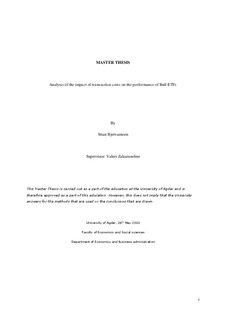| dc.description.abstract | Since 2008 both Handelsbanken and DnbNOR have offered the Bull funds on the Oslo stock exchange. These are funds whose shares trade like stocks on the stock exchange, and the fund provide investors with twice the daily return of the OBX-index. In order to do so, the fund managers utilize OBX-stock index futures contracts. Fund managers take long futures positions of twice the value of the fund to achieve the double exposure. To maintain the double exposure, fund managers must rebalance the fund at the end of each trading day. They do this by adjusting the number of futures contracts so that the exposure is always twice that of the funds value. The transaction costs associated with rebalancing is deducted from the value of the fund. This master thesis investigates if such transaction costs affect the performance of the Bull fund, and whether the magnitude of the transaction costs effect on performance might depend on the level of expected return and standard deviation of the benchmark stock index.
Our results are based on data from simulation runs, using MATLAB. First, we compute and compare M-squared performance measures with and without transaction costs with the stock index as the benchmark. M-squared performance measures are computed for 6 time horizons ranging from daily to yearly. We find that the Bull fund generally underperforms the benchmark both with and without transaction costs, but that the underperformance is always greater with transaction costs. The M-squared performance, both with and without transaction costs, also show a decrease in performance for both higher values of the benchmark’s expected return and standard deviation. Comparing M-squared measures reveals that differences in performance become greater against higher values of the benchmark’s standard deviation. Difference in M-squared measures also shows a decrease in differences, for longer time horizons, against higher values of the benchmark’s expected return. Simulation data is also used to estimate expected returns and standard deviation, with 95% confidence intervals, for daily, weekly and monthly time horizons. Analysis shows that standard deviations are not significantly different for any of these time horizons, while the expected return of weekly and monthly time horizons are significantly reduced by transaction costs. However, we are not able to explain the increase in M-squared difference against higher values of the benchmarks standard deviation and the decrease in M-squared differences for higher values of the iv
benchmark’s expected return, by analyzing the estimated expected returns and standard deviations. | en_US |
